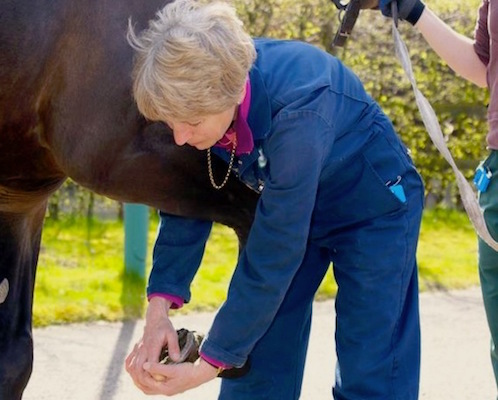The study confirms that veterinarians are trained to use a "Ridden Horse Ethogram" are better able to recognize pain-related behavior in horses, which may reflect lameness or back or sacroiliac pain. This should in turn help practitioners communicate potential performance problems more effectively with their clients.
Conducted by Dr Sue Dyson, Head of Clinical Orthopedics at the Centre for Equine Studies at the Animal Health Trust in Newmarket, England, the study compared the real-time application of the Ridden Horse Ethogram with analysis of video recordings of the horses by a trained assessor; the study questioned whether veterinarians, after preliminary training, could apply the ethogram in real time in a consistent way and in agreement with an experienced assessor.
Twenty horse-and-rider combinations were used for the study. The horses were in regular work and were capable of working ‘on the bit’. The horses were assessed by a chartered physiotherapist and the fit, placement, balance and suitability of each horse’s saddle was checked by a saddle fitter qualified by Great Britain's Society of Master Saddlers (SMS). (Eleven horses were found to have ill-fitting saddles and 14 had back muscle tension or pain but these did not influence the behavior scores.)
 |
The horses were also assessed by an independent lameness expert. Sixteen showed low-grade lameness or abnormalities of canter, which were likely to be pain induced but did not prevent the horses from being used for the study.
All 20 horses were given a 15-minute ridden warm-up before executing an eight-minute purpose-designed preliminary level dressage test. During each dressage test, a team of ten equine veterinarians, who were selected from 40 volunteers and given preliminary training, applied the Ridden Horse Ethogram.
The veterinarians assessed each horse for the presence of a total of 24 behaviors that occur more commonly in lame horses compared with non-lame horses. It has previously been shown that the presence of more than eight behavioral markers is likely to indicate the presence of musculoskeletal pain.
Each behavior received a binary score of "present" or "absent". The ethogram was also applied to each horse by an experienced trained assessor (Dr Dyson) and the tests were filmed so that the experienced assessor could make a comparison between her real-time behavior assessments and video analysis.
 |
| Ridden horse ethogram points noted in this horse during evaluation: 1) Front of head is more than 30⁰ in front of the vertical; 2) Ears area is behind the vertical for five seconds; 3) Intense stare; 4) Bit pulled through. |
Good agreement was found between the expert’s scores and the volunteer veterinarians’ scores, with excellent consistency in overall agreement among the volunteers. The scores also reflected the volunteers’ capacity to use the ethogram to identify lameness status, with higher scores awarded to the lame horses compared with the non-lame horses. There was no significant difference in real-time scores and video-based scores for the experienced assessor, verifying the reliability of the system.
“The study confirms that,with basic training, veterinary observers can use the ridden horse ethogram with consistency as an effective tool to help identify musculoskeletal pain which could reflect lameness or back or sacroiliac pain,” said Dr Dyson. “The volunteers were unanimously positive about the potential value of the ethogram in helping them to determine the presence of musculoskeletal pain in horses performing poorly or at pre-purchase examinations.”
 |
| Ridden horse ethogram points noted in this horse during evaluation: 1) Head tilt; 2) Mouth open, exposing teeth, for ten seconds; 3) Ears behind vertical for five seconds. |
Dr Dyson and her team are now working with Equitopia, an American educational resource, in conjunction with Padma Videos, to produce a training video to enable vets, owners, riders, trainers and paraprofessionals to learn how to apply the Ridden-Horse-Ethogram.
• • • • •
Reference: Can veterinarians reliably apply a whole horse ridden ethogram to differentiate non lame and lame horses based on live horse assessment of behaviour? S. Dyson, K. Thomson, L. Quiney, A. Bondi and A. D. Ellis Equine Vet. Educ. 2019, doi: 10.1111/eve.13104
(Note: a journal subscription or library access is required to read the full text of this article, which was published online April 9, 2019; the abstract page is free to view.)
A news release provided by the Animal Health Trust, an independent British charity and veterinary referral center, was used as the basis of this article.
© Fran Jurga and Hoofcare Publishing; Fran Jurga's Hoof Blog is the news service for Hoofcare and Lameness Publishing. Please, no re-use of text or images on other sites or social media without permission--please link instead. (Please ask if you need help.) The Hoof Blog may be read online at the blog page, checked via RSS feed, or received via a headlines-link email (requires signup in box at top right of blog page). Use the little envelope symbol below to email this article to others. The "translator" tool in the right sidebar will convert this article (roughly) to the language of your choice. To share this article on Facebook and other social media, click on the small symbols below the labels. Be sure to "like" the Hoofcare and Lameness Facebook page and click on "get notifications" under the page's "like" button to keep up with the hoof news on Facebook. Questions or problems with the Hoof Blog? Click here to send an email hoofblog@gmail.com.
Read this blog's headlines on the Hoofcare + Lameness Facebook Page
Disclosure of Material Connection: The Hoof Blog (Hoofcare Publishing) has not received any direct compensation for writing this post. Hoofcare Publishing has no material connection to the brands, products, or services mentioned, other than products and services of Hoofcare Publishing. I am disclosing this in accordance with the Federal Trade Commission’s 16 CFR, Part 255: Guides Concerning the Use of Endorsements and Testimonials in Advertising.





